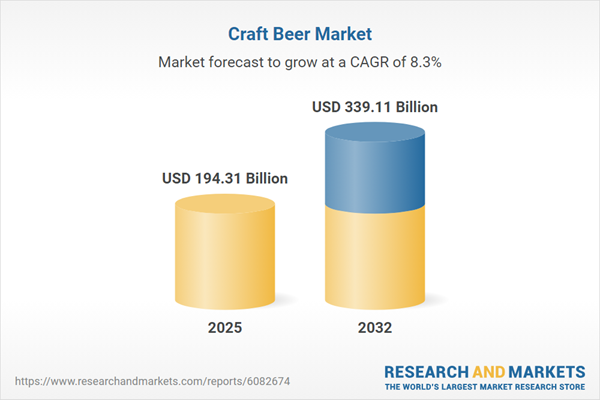Speak directly to the analyst to clarify any post sales queries you may have.
Amid rapid industry transformation, the craft beer market faces changing consumer tastes, evolving brewing techniques, and a more sophisticated production landscape. Senior decision-makers are navigating increasing complexity—aligning operational innovation, targeted distribution, and brand repositioning to engage new customer bases and adapt to shifting regulations.
Market Snapshot: Craft Beer Market Overview
The craft beer market expanded from USD 179.56 billion in 2024 to USD 194.31 billion in 2025 and is projected to reach USD 339.11 billion by 2032 at a CAGR of 8.27%. Sustained growth is driven by ongoing product innovation, a rising number of independent breweries, and growing consumer demand for diverse flavor profiles and sustainable practices. Companies are leveraging digital platforms and regional expansion strategies to engage broader audiences, while rapid adoption of advanced brewing technologies and integrated supply chains underpin operational agility.
Scope & Segmentation
- Product Types: Ale varieties (Amber, Brown, Pale); IPA styles (Double, New England, Session); Lager choices (Märzen, Pilsner); and other categories including Porter and Stout (Imperial, Oatmeal).
- Packaging: Bottles, cans, and kegs—each supporting efficiency, distribution, and brand differentiation for both established and emerging producers.
- Distribution Channels: Off-trade channels (convenience stores, liquor outlets, supermarkets) and on-trade channels (bars, restaurants) broaden product accessibility across key points of sale.
- Consumer Age Groups: Market activity is primarily driven by segments aged 21-30, 31-40, 41-50, and those aged 51 and above.
- Price Ranges: Premium, standard, and super premium product tiers are deployed to match diverse value perceptions and purchasing patterns across consumer segments.
- Regions: Global coverage includes the Americas, Europe, Middle East, Africa, and Asia-Pacific; major markets encompass the U.S., Canada, Brazil, UK, Germany, China, India, and other important territories.
- Featured Companies: Key industry players stand out, including D. G. Yuengling & Son, The Boston Beer Company, Sierra Nevada Brewing, Duvel Moortgat USA, New Belgium Brewing, Bell’s Brewery, Tröegs Independent Brewing, Stone Brewing, Deschutes Brewery, and Oskar Blues Brewery.
Key Takeaways for Decision-Makers
- Breweries prioritize continuous innovation using unique ingredients, creative blends, and limited small-batch releases to establish differentiation and brand engagement in a crowded landscape.
- As consumer values shift, brands emphasize authentic storytelling, transparent sourcing, and production visibility to attract and retain premium customer groups.
- Omni-channel distribution strategies combine direct-to-consumer models with digital retail platforms, whereas adaptive logistics respond promptly to regulatory changes and customer trends.
- Operational efficiency and sustainable market positioning rely on recyclable packaging and lighter container options.
- Success in different regions depends on local preference analysis, regulatory navigation, and resilient supply chains, supporting scalable and adaptive market entry approaches.
- Advanced digital marketing analytics inform product development and regional market targeting, allowing brewers to respond swiftly to shifting demographics and emerging demand patterns.
Tariff Impact: Influencing Supply Chain and Production Strategies
Recent tariff measures on imported raw materials and packaging are driving up input costs for U.S. producers, adding complexities to the supply chain. To address these challenges, breweries are increasing reliance on alternative sourcing, prioritizing local ingredient networks, and fortifying relationships with suppliers for better cost control. Strategic alliances in key raw materials like specialty hops and grains help mitigate price fluctuations. Such shifts require refined international expansion strategies and regulatory response, particularly affecting smaller breweries seeking resilience during volatile periods.
Methodology & Data Sources
This report combines executive interviews, large-scale surveys, trade publications, regulatory analysis, and academic research. All results are triangulated and validated through continuous expert review, supporting reliable insights for high-level strategic use.
Why This Report Matters
- Enables leadership to identify core market drivers, anticipate risks, and plan both tactical actions and longer-term strategies in a shifting sector.
- Supports strategic resource allocation, portfolio optimization, and builds competitive go-to-market plans attuned to evolving channel and regional dynamics.
- Prepares executive teams to manage supply chain complexity, regulatory change, and competitive behavior at both global and local levels.
Conclusion
With a focus on innovation, consumer alignment, and agile operating strategies, companies remain well-positioned to capture new growth and outperform in increasingly complex environments.
Table of Contents
3. Executive Summary
4. Market Overview
7. Cumulative Impact of Artificial Intelligence 2025
Companies Mentioned
The companies profiled in this Craft Beer market report include:- D. G. Yuengling & Son, Inc.
- The Boston Beer Company, Inc.
- Sierra Nevada Brewing Co.
- Duvel Moortgat USA, Inc.
- New Belgium Brewing Co.
- Bell's Brewery, Inc.
- Tröegs Independent Brewing, LLC
- Stone Brewing Co.
- Deschutes Brewery, Inc.
- Oskar Blues Brewery, LLC
Table Information
| Report Attribute | Details |
|---|---|
| No. of Pages | 188 |
| Published | November 2025 |
| Forecast Period | 2025 - 2032 |
| Estimated Market Value ( USD | $ 194.31 Billion |
| Forecasted Market Value ( USD | $ 339.11 Billion |
| Compound Annual Growth Rate | 8.2% |
| Regions Covered | Global |
| No. of Companies Mentioned | 11 |









